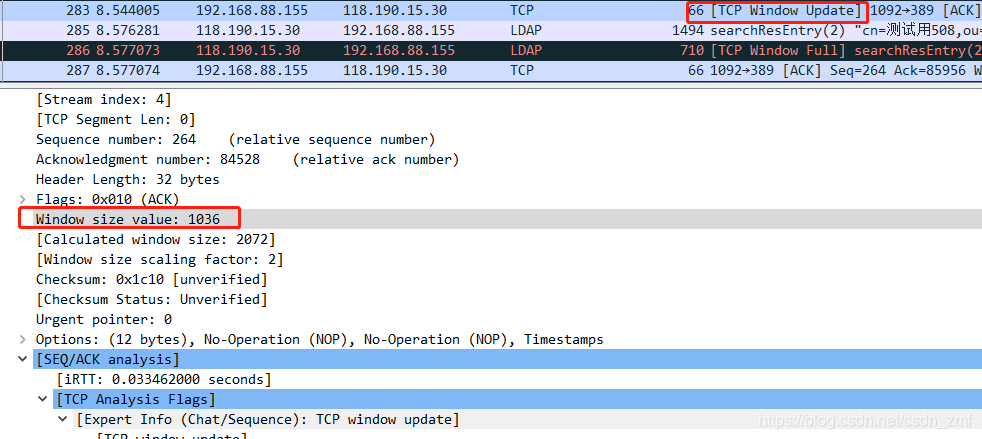TCP window full, 是指的发送端发送的数据已经达到的接受窗口的上限。
继而停止发送,等待新的接收窗口的通告
此时接收端返回的是TCP zero window,表示接收端窗口为0,从抓包可以看出
 接收端在清除缓存后窗口不再为0时,更新了其窗口大小
接收端在清除缓存后窗口不再为0时,更新了其窗口大小
 出现该情况是可考虑将TCP socket中的设置TCP_NODELAY选项。
出现该情况是可考虑将TCP socket中的设置TCP_NODELAY选项。
setsockopt( s, IPPROTO_TCP, TCP_NODELAY, (char*) &dummy, sizeof(dummy) )
在编译器头文件中找到该宏的定义,编译ldap也发现该宏始终是开着的,即默认不使用Nagle算法
root@ubuntu-64bit:# grep -rnwa "TCP_NODELAY" /opt/mv_tools
/opt/mv_tools/mipsel-linux-uclibc/sys-root/usr/include/linux_bak/tcp.h:118:#define TCP_NODELAY 1 /* Turn off Nagle's algorithm. */
/opt/mv_tools/mipsel-linux-uclibc/sys-root/usr/include/linux/tcp.h:118:#define TCP_NODELAY 1 /* Turn off Nagle's algorithm. */
/opt/mv_tools/mipsel-linux-uclibc/sys-root/usr/include/netinet/tcp.h:40:#define TCP_NODELAY 1 /* Don't delay send to coalesce packets */
在代码中没找到TCP_NODELAY宏在哪里定义,于是在编译器头文件中找到该宏
TCP window full, 是指的发送端发送的数据已经达到的接受窗口的上限。继而停止发送,等待新的接收窗口的通告。
发生TCPwindow Full
的情况分析,下面得包是抓取的FTP的streamflow. 当时的情况是正在发生在客户端上传文件到服务器。
本地主机:146.11.2.87
远端服务器:147.128.6.103
首先看第28406个包,服务器通告本段A
此前在对接视频平台过程中,获取的视频超过7路,会出现TCP window full的错误,然后获取的视频流会断掉。
产生问题的原因:
业务处理过程中速度不够,导致客户端向服务端发送零窗口的错误,最终导致服务端端口卡死。只有等到socket关闭,服务器端的业务才会恢复。
现象:出现断流后,从客户端获取的视频平台码流也断了,说明端口被堵住了。重启程序或客户端(关闭socket连接)后视频业...
1、作为接收方,有接收窗口,也就是接收缓冲区,win=xxx 告诉对方,我的接收窗口大小。
2、当我的接收窗口满了,也就是win=0,Wireshark显示【TCP ZeroWindow】,这个时候,对方不能再发送数据。
3、作为发送方,有发送窗口,发送窗口可以理解为,一口气可以发送多少数据。发送窗口不光要考虑对方的接收窗口,还要考虑网络情况,也就是拥塞窗口,等于它们的最小值。
发送窗口数据分...
Hi, i'm having some questions about the TCP ZeroWindow flag. According to my
capture we have the following scene:
98408 16:55:40.447814 192....
去年我师傅推荐了两本林沛满写的关于wireshark抓包的书,分别是《wireshark就是这么简单》和《wireshark分析的艺术》,写的真心不错。
TCP协议是一个很有意思的内容,这半年对TCP协议有了更多的认识,于是想重新更新一些对TCP协议的内容。今天先从TCP协议里面的滑动窗口说起。
1、先说原理
就发送端来说,一般如下所示:
主要分为:已发送已确认的包(应用层未读取)。发送未确认的包,未发送可发送的包,未发送不可发送的包。其中,滑动窗口指的是发送未确认和未发送可发送区域的大小。
2、滑动窗口
当接收端的接收窗口被完全占用后,此时再来新的数据包就无处安放了,同时接收方回复给发送方的ACK中,Win也已经归零。上一文的示例中,接收端接收到消息后,并不处理,所以会一直占用接收端的接收窗口,一直到最后,完全占用了接收窗口。当接收方重新获取可用空间时,会给发送端传输一个窗口更新,发送端接收到该数据包之后,继续发送数据。假设一种情况,接收方发送窗口更新包丢失了,那么发送端就一直无法得到窗口更新的消息,一直在等待。为了避免这种互相等待的死锁情况,发送端会采用一个持续计时器,间歇性的查询接收端的窗口信息。...
TCP/IP协议为流控制协议,TCP窗口是其中一个重要的概念。在TCP接受和发送端都有缓存区,用户缓存数据,当缓存区满的时候就不能在向缓存区中写入数据了。发送缓存区满表现为send的返回值不再是指定的字节数,而小于该值的一个值;而接收缓存区满表现为对端发送收到影响。
[TCP Window Full] :服务端向客户端发送的一种窗口警告,表示已经发送到数据接收端的极限了。
[TCP Window Update]:缓冲区已释放为所示的大小,因此请恢复传输。
[Zero Window] :客户端向服务端发送的一
早先写了一篇《关于TCP Zero Window Update感知的非常棒的优化》,大意是当数据接收端由于缓冲区配额问题导致丢包时,发送端是无法区分这种情况和拥塞丢包的,最终的结果依然是超时退避重传,在接收端发送窗口更新并被发送端收到的时候,这个窗口更新不会打扰正在退避重传中的逻辑,如果有退避等待正在进行,且这个等待重传的数据包占据了通告窗口,那么在重传定时器到期之前,将不会有任何数据被发送。
usage: qemu [options] [disk_image]
'disk_image' is a raw hard disk image for IDE hard disk 0
Standard options:
-h or -help display this help and exit
-version display version information and exit
-machine [type=]name[,prop[=value][,...]]
selects emulated machine (-machine ? for list)
property accel=accel1[:accel2[:...]] selects accelerator
supported accelerators are kvm, xen, tcg (default: tcg)
-cpu cpu select CPU (-cpu ? for list)
-smp n[,maxcpus=cpus][,cores=cores][,threads=threads][,sockets=sockets]
set the number of CPUs to 'n' [default=1]
maxcpus= maximum number of total cpus, including
offline CPUs for hotplug, etc
cores= number of CPU cores on one socket
threads= number of threads on one CPU core
sockets= number of discrete sockets in the system
-numa node[,mem=size][,cpus=cpu[-cpu]][,nodeid=node]
-fda/-fdb file use 'file' as floppy disk 0/1 image
-hda/-hdb file use 'file' as IDE hard disk 0/1 image
-hdc/-hdd file use 'file' as IDE hard disk 2/3 image
-cdrom file use 'file' as IDE cdrom image (cdrom is ide1 master)
-drive [file=file][,if=type][,bus=n][,unit=m][,media=d][,index=i]
[,cyls=c,heads=h,secs=s[,trans=t]][,snapshot=on|off]
[,cache=writethrough|writeback|none|directsync|unsafe][,format=f]
[,serial=s][,addr=A][,id=name][,aio=threads|native]
[,readonly=on|off]
use 'file' as a drive image
-set group.id.arg=value
set parameter for item of type
i.e. -set drive.$id.file=/path/to/image
-global driver.property=value
set a global default for a driver property
-mtdblock file use 'file' as on-board Flash memory image
-sd file use 'file' as SecureDigital card image
-pflash file use 'file'
TCP—Zero Window
Zero Window is something to investigate.
TCP Zero Window is when the Window size in a machine remains at zero for a specified amount of time.
This means that a client is not able to...
 接收端在清除缓存后窗口不再为0时,更新了其窗口大小
接收端在清除缓存后窗口不再为0时,更新了其窗口大小
 出现该情况是可考虑将TCP socket中的设置TCP_NODELAY选项。
出现该情况是可考虑将TCP socket中的设置TCP_NODELAY选项。